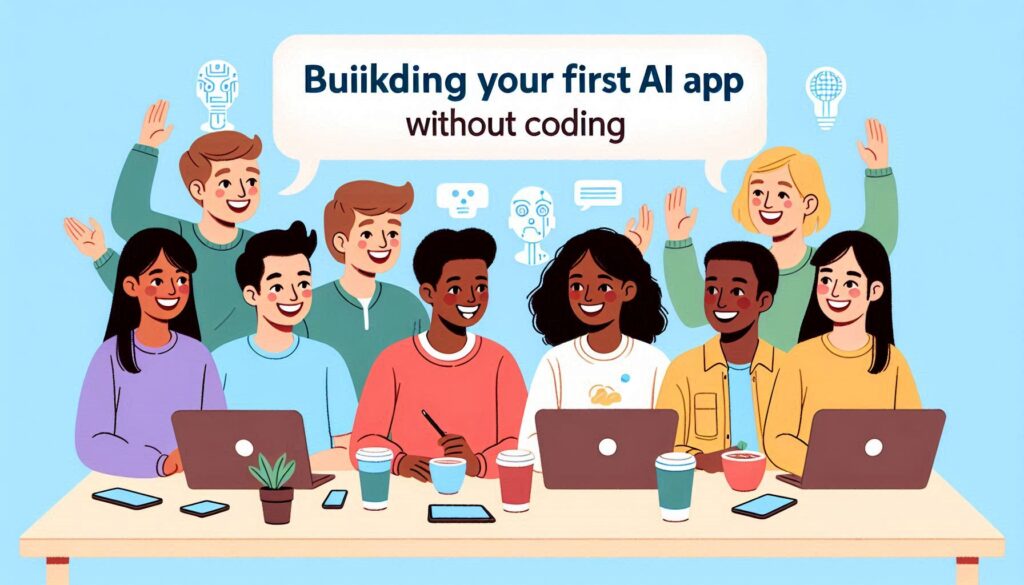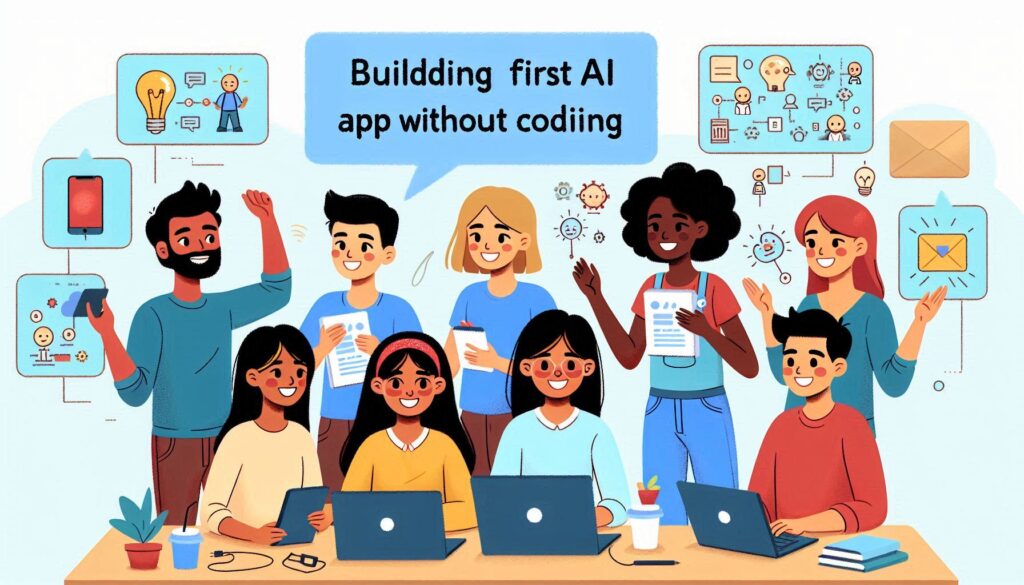Artificial Intelligence (AI) is no longer a concept reserved for tech experts or large corporations. With no-code platforms and tools, anyone with a creative idea can develop their AI-powered app without writing a single line of code. Whether you’re a small business owner, a student, or just a curious individual, building an AI app has become accessible and straightforward.
In this blog, we’ll guide you through creating your first AI app step by step, leveraging no-code platforms to make the process both fun and productive. Let’s explore How to Create First AI App Without Coding
1. What Is a No-Code AI App?
A no-code AI app is a software application that leverages artificial intelligence technologies such as natural language processing (NLP), machine learning (ML), or computer vision, built using platforms that require no programming knowledge. These platforms provide pre-designed templates, drag-and-drop tools, and integrations with AI models like GPT, OpenAI, or TensorFlow to simplify the process.
For example, an app that recommends recipes based on ingredients you input is an AI app using NLP and recommendation algorithms.

2. Why Build an AI App?
AI apps are transforming industries and daily life, offering smarter, personalized solutions. Here are some reasons you should consider building one:
- Automate Tasks: Use AI to handle repetitive or time-consuming tasks.
- Solve Problems Creatively: Leverage AI for tasks like predicting trends, analyzing data, or generating content.
- Accessibility: Democratize access to advanced technology, making it available to more people.
- Business Growth: Improve customer engagement, optimize workflows, or create unique selling points for your business.
- Learning Opportunity: Develop a deeper understanding of AI technology and its applications.
3. Essential Tools and Platforms
Here are some of the most popular no-code platforms for building AI apps:
- Bubble
- Features: Drag-and-drop editor, database integration.
- Use Cases: E-commerce, dashboards, AI chatbots.
- FlutterFlow
- Features: Build mobile apps with integrations for Firebase and APIs.
- Use Cases: AI-based mobile apps like recommendation systems or chat assistants.
- Zapier
- Features: Workflow automation and app integrations.
- Use Cases: Automate tasks such as lead generation, email sorting, or data organization.
- OpenAI’s API
- Features: Integrate GPT models for text generation or NLP tasks.
- Use Cases: Chatbots, content generation, code assistance.
- Teachable Machine
- Features: Train custom machine learning models.
- Use Cases: Image classification, sound recognition, pose detection.
- Thunkable
- Features: Mobile app development with AI features.
- Use Cases: AI-based calculators, fitness trackers, or language translators.
4. Step-by-Step Guide to Building an AI App
Step 1: Define Your Idea
Start by identifying a problem you want to solve or an experience you want to enhance. This is crucial for a focused and efficient app-building process.
- Example Ideas:
- A chatbot that helps users with mental health support.
- A personal finance tracker powered by AI.
- An app that generates meal plans based on dietary preferences.
Once you have an idea, outline the following:
- Target audience.
- Core functionality.
- Features powered by AI (e.g., recommendations, predictions, or natural language understanding).
Step 2: Choose the Right Platform
Pick a no-code platform that matches your app’s requirements. For instance:
- For a web-based AI app: Use Bubble or Webflow.
- For a mobile app: Go with FlutterFlow or Thunkable.
- For AI-specific functionality: Integrate tools like OpenAI or TensorFlow.
Step 3: Design the User Interface
Your app’s user interface (UI) determines how users interact with it. Use drag-and-drop editors on no-code platforms to design an intuitive and visually appealing layout.
- Key Tips for UI Design:
- Keep the layout simple and clean.
- Use clear labels and instructions.
- Ensure accessibility with readable fonts and appropriate color contrasts.
For example, if you’re building a recipe app, include:
- A search bar for ingredients.
- A list of recommended recipes.
- Buttons for filtering results.
Step 4: Integrate AI Features
This is where your app gets its “intelligence.” Depending on your app’s purpose, choose and integrate the appropriate AI functionalities.
- Chatbots or Assistants
- Use OpenAI’s GPT API to enable conversation-like interactions.
- Image Recognition
- Use tools like Teachable Machine to train models to recognize specific objects or patterns.
- Data Analysis and Predictions
- Integrate machine learning models via platforms like Google Cloud AI or AWS.
- Voice-to-Text or Text-to-Speech
- Use APIs such as Google Text-to-Speech or Speech-to-Text.
Step 5: Test and Optimize
Before launching your app, thoroughly test its features:
- Functionality Testing: Ensure all buttons, inputs, and outputs work correctly.
- Performance Testing: Check loading times and responsiveness.
- User Feedback: Share your app with a small group of users and collect their feedback.
5. Real-Life Use Cases of AI Apps
Here are some real-world examples of AI apps that were built using no-code tools:
- Personalized Learning Apps
- Apps that recommend learning resources based on user preferences.
- Customer Support Chatbots
- AI-powered chatbots that handle customer queries and reduce response time.
- Fitness Trackers
- Apps that use AI to track workouts and provide personalized fitness plans.
- Market Analysis Tools
- Apps that analyze sales data and predict future trends.
6. Tips for Success
- Start Small: Focus on one core feature before expanding your app.
- Leverage Tutorials: Most no-code platforms have extensive tutorials and community forums.
- Iterate Quickly: Gather user feedback and make improvements frequently.
- Learn the Basics of AI: While coding isn’t required, understanding AI principles will help you make informed decisions.
7. Future of AI and No-Code Development
The rise of no-code platforms is democratizing app development, enabling anyone to create impactful AI solutions. As these platforms evolve, we can expect:
- More accessible AI features.
- Advanced customization without requiring coding.
- Integration with cutting-edge AI models for complex applications.
Additional Insights on Building Your AI App
To ensure your journey into creating your first AI app is seamless, let’s explore some additional key aspects, including monetization strategies, troubleshooting common challenges, and resources to deepen your understanding of AI and no-code development.
Monetization Strategies for Your AI App
Once your app is ready, you might consider monetizing it, depending on its purpose and audience. Here are some strategies to explore:
- Freemium Model:
- Offer basic features for free and charge for premium features like enhanced AI capabilities or ad-free experiences.
- Example: A language-learning app that provides free lessons but charges for advanced grammar tools or personalized quizzes.
- Subscription Model:
- Charge users a recurring fee (monthly or annually) to access your app’s services.
- Example: A fitness app that uses AI to generate personalized workout plans and meal recommendations.
- Pay-Per-Use:
- Charge users based on the number of times they use specific features.
- Example: An AI-powered image recognition app charging for each image processed.
- Ads and Sponsorships:
- Generate revenue by displaying ads or partnering with brands.
- Example: An AI news aggregator app displaying sponsored content alongside user-curated news.
- Data Licensing:
- If your app gathers valuable data (while adhering to privacy laws), you can license anonymized insights to businesses.
- Example: An AI app that analyzes market trends and licenses data to financial firms.
Troubleshooting Common Challenges
Building an AI app can be straightforward with no-code tools, but challenges may still arise. Here’s how to address some common issues:
- Integration Errors:
- Problem: AI features not working as expected or failing to connect with APIs.
- Solution: Double-check API keys, endpoints, and documentation. Most platforms provide debugging tools to identify errors.
- Performance Issues:
- Problem: Slow response times or unresponsive features.
- Solution: Optimize your app by minimizing unnecessary features, reducing image sizes, or caching data.
- User Experience Problems:
- Problem: Users find the app confusing or difficult to navigate.
- Solution: Test your app with real users and implement their feedback to improve usability.
- Scalability Concerns:
- Problem: Your app struggles to handle increased traffic or data.
- Solution: Choose platforms with scalable backends or integrate cloud services like Firebase or AWS.
- AI Accuracy Issues:
- Problem: The AI model provides incorrect or inconsistent results.
- Solution: Train the AI model with more diverse data or choose pre-trained models that better suit your needs.
Resources to Enhance Your Knowledge
While no-code platforms simplify the development process, expanding your knowledge about AI and app development will make you more confident and creative.
- Online Courses:
- Coursera: Offers beginner-friendly courses like “AI for Everyone” by Andrew Ng.
- Udemy: Explore courses like “No-Code AI App Development” for hands-on learning.
- Books:
- “Artificial Intelligence: A Guide to Intelligent Systems” by Michael Negnevitsky.
- “No-Code: Build Your App Without Coding” by David Siteman Garland.
- Communities and Forums:
- Join online communities like Reddit’s r/NoCode or specialized forums for tools like Bubble and FlutterFlow.
- Webinars and Tutorials:
- Attend webinars hosted by no-code platforms to learn directly from experts.
- Explore YouTube channels dedicated to no-code development.
Scaling Your AI App
Once your app gains traction, consider scaling its features and reach. Here’s how:
- Add Advanced AI Features:
- Introduce new capabilities like voice commands, real-time analytics, or multilingual support.
- Expand Platforms:
- If your app started as mobile-only, consider creating a web version or vice versa.
- Partner with Other Businesses:
- Collaborate with brands or companies to enhance your app’s offerings and reach.
- Leverage Feedback:
- Continuously gather and implement user feedback to refine your app.
- Optimize Marketing Strategies:
- Use AI tools to create targeted marketing campaigns and reach a broader audience.
Final Thoughts
Building your first AI app without coding is an empowering experience. No-code platforms have made it easier than ever to bring your ideas to life, regardless of your technical background. From defining your concept to launching and scaling your app, the possibilities are endless.
Remember, the key to success lies in starting small, learning along the way, and iterating based on user feedback. With determination and the right tools, you can create an app that not only solves real-world problems but also establishes you as a creative innovator in the AI space.
So, what are you waiting for? Dive in, explore, and create something extraordinary!
Let us know in the comments about your experience building your first AI app. We’d love to hear your success stories and challenges!
Conclusion
Building your first AI app without coding is an exciting and achievable goal. By leveraging no-code platforms, you can bring your ideas to life, solve real-world problems, and tap into the transformative potential of AI. Start today, and who knows? Your app could be the next big thing in the AI world!
Let us know your thoughts and share your AI app-building journey in the comments below!
Explore More:
AI Tools to Launch Your Startup on a Budget: A Comprehensive Guide – Discover affordable AI tools that can help kickstart your startup journey and drive success without breaking the bank!


